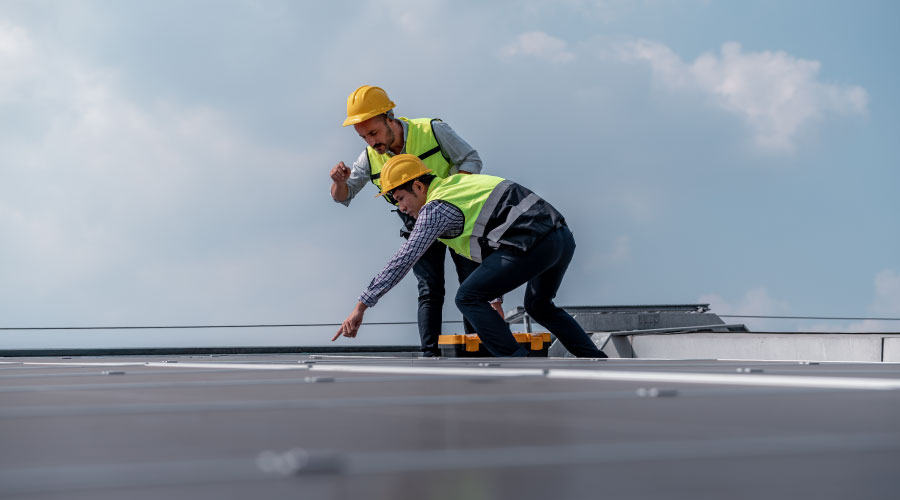Insulation, Climate Can Affect Roof's Energy Efficiency
6. Cool Roofs and Insulation
The use of increased insulation in conjunction with a cool roof can also be a source of energy efficiency. Some states, municipalities and utilities have initiated tax benefits, rebates or paybacks to building owners who increase the thermal value of the insulation that they provide on their roof systems.
Proper research should be conducted prior to the installation of insulation. A dew-point calculation should be conducted based on the building's interior use to determine the correct thermal R-value prior to application. This can help a building avoid condensation issues.
ASHRAE 90.1 is the basis for energy codes in many states. The R-value required by the 2007 revision to ASHRAE 90.1 differs by region of the country. For example, the above-deck insulation requirement in Zone 3 (including most Southeastern states, except Florida) buildings is R-20. The new ASHRAE standard 189.1 sets the minimum insulation requirement at R-25.
7. Cool Roofs in Cool Climates
A current industry debate focuses on the merits of cool roofs in the colder northern regions of the country. Akbari says that although the warmer climates (Sunbelt regions) benefit more from cool roofs, "cool roofs can save energy in all buildings that need air conditioning cooling in all regions of the United States."
In cooler climates, proper reflectivity coupled with proper emissivity will provide year-round energy savings.
Another aspect to consider is the size of the facility. The energy savings provided on a multimillion square foot facility from a reflective surface can be substantial even if it is based on HVAC savings over only a three- to four-month period.
It's also important to note that there are several industry studies in progress about whether a black roof with a higher amount of insulation may have more energy benefits than a cool roof in a cool climate.
8. Vegetative Roofs
Green or garden roofs can provide an urban area with greenery to reduce the urban heat island effect. Because of their mass and reflective properties, garden roofs can help reduce cooling energy use.
Garden roofs also reduce stormwater run off — a major advantage in older urban areas with limited or decrepit infrastructure.
There are two types of green roofs: extensive and intensive. Intensive green roofs have a planting media that is at least a foot deep, and include everything from bushes and shrubs to small trees. Extensive green roofs have a planting media from 1 to 5 inches thick and are usually not walkable.
9. Roof Coatings
The Heat Island Group has been working in conjunction with manufacturers to provide advanced cool roof technology. One example is roof coatings. Coating manufacturers have developed products for low-slope systems that provide high reflectance rates, usually better than .65. These coatings can be applied over most low-slope roof materials.
Sometimes, commercial coatings are colored with conventional pigments that absorb the near-infrared radiation that provides more than half the power of sunlight. The Heat Island Group has found that by replacing conventional pigments with "cool" pigments that reflect more near-infrared radiation, reflectances that approach those of white roofs can be achieved on colored roofs.
10. Longer Life
The sun's rays have a significant impact on the life of a roof system. At the simplest level, maintaining a cooler surface temperature means less heat-related expansion and contraction, and therefore a longer roof life.
John D'Annunzio, president of Paragon Consultants and Paragon Roofing Technology, Inc., has published three books about roofing.
RADIATION
UV vs. Your Roof
Cool roofs are designed to reflect a majority of the sun's ultraviolet (UV) radiation. The biggest reason is that UV radiation has a negative effect on just about any type of roof.
For example, in built-up roof systems, UV radiation degrades exposed bitumen through a chemical process known as photo-oxidation. In photo-oxidation, the number of high-molecular-weight hydrocarbons and water-soluble products in bitumen are increased. The combination of heat and UV radiation results in a migration of oily constituents to the surface and hardens the bitumen. The bitumen, in its hardened form, cracks. Mineral aggregate surfacing is applied on built-up roof systems to protect the bitumen flood coat from service-life-shortening UV radiation.
UV radiation may also have a destructive effect on unreinforced polyvinyl chloride (PVC) membranes. The plasticizer in the PVC compound can migrate out of solution through exposure to UV radiation. Because the plasticizer is applied in the PVC compound to provide flexibility to the membrane, the diffusion results in an embrittled, hardened membrane which is susceptible to shrinkage, cracking and shattering.
UV radiation also contributes to the loss of oils from EPDM membranes causing shrinkage of the sheets. Most elastomeric membranes obtain UV resistance from a compound additive called carbon black. Carbon black screens the UV radiation from being absorbed by the chemicals included in the polymer mixture.
Modified bitumen membranes incur deterioration from the same photo-oxidation that attacks asphalt-based built-up roof systems. This is due to the asphalt content in modified bitumen membranes. To protect against UV deterioration, the modified bitumen membranes utilize a variety of shielding surfacings, such as factory embedded mineral granules, metal foils, and field-applied reflective coatings.
— John D'Annunzio
|

Related Topics:













